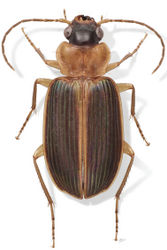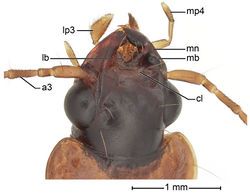Badister
| Notice: | This page is derived from the original publication listed below, whose author(s) should always be credited. Further contributors may edit and improve the content of this page and, consequently, need to be credited as well (see page history). Any assessment of factual correctness requires a careful review of the original article as well as of subsequent contributions.
If you are uncertain whether your planned contribution is correct or not, we suggest that you use the associated discussion page instead of editing the page directly. This page should be cited as follows (rationale):
Citation formats to copy and paste
BibTeX: @article{Erwin2011ZooKeys147, RIS/ Endnote: TY - JOUR Wikipedia/ Citizendium: <ref name="Erwin2011ZooKeys147">{{Citation See also the citation download page at the journal. |
Ordo: Coleoptera
Familia: Carabidae
Name
Badister Clairville, 1806 – Wikispecies link – Pensoft Profile
Type species
Carabus bipustulatus Fabricius, 1792: 161
Number of described Western Hemisphere species: 16
Taxonomy
Stable, although several recently collected undescribed species need to be treated. Adelphotaxon: not determined.
Geographic Distribution
Members of this genus occur in the Antillean sub-region of the Neotropical Region, Amazon Basin of Perú, the Holarctic Region, Afrotropical Region, in the Cape sub-region, and on the island of Madagascar (Ball 1959[1]), Oriental Region eastward to Java, and the Australian Region, including New Guinea and eastern Australia (Darlington 1968[2]: 15).
Habitat
Wet and moist areas including shaded margins of vernal pools in deciduous forests, open margins of alkaline lakes, secondary floodplains of river banks, at eutrophic marshes, pond and lakes, in disturbed places such as gravel pits, vacant lots, pastures, and cultivated fields (e.g., barley).
References
(Ball (1959[1], 1992), Jeannel (1942)[3], Larochelle and Larivière (2003)[4].
Diagnostic combination
(modified from Ball 1959[1]).— With character states of subtribe Licinina (Ball 1992[5]: 347, in key), and the following: Length not exceeding 10 mm, body glabrous, except for certain constant setae mentioned below; mandibles thick, either right or left mandible with deep transverse notch in dorsal surface, notch preceded proximally by a prominent boss; tibial spurs finely serrulate; antennomeres 3–11 densely setose.
Description
Head (Fig. 2) with two supraorbital setigerous punctures per eye, frontal impressions usually shallow, basin-like. Clypeus (cl) markedly and slightly asymmetrically emarginate, not divided into two portions by the emargination, deflected ventrally, forming an angle of somewhat less than 90 degrees with the front, bearing a single long seta on each side, each of which originates in a broad approximately triangular pit. Eyes prominent. Antenna with complex variety of sense organs beginning on antennomere 3 (a3). Labrum (lb) about 2/3 as wide as clypeus, deeply bilobed, cleft anteriorly almost extended to base, with three setae on each lobe. Mandibles very short and obtuse, terebra markedly reduced, apparently edentate; either right or left mandible deeply notched (mn), preceded by a prominent swelling, or boss (mb). Maxillary palpi long and slender, palpomere 4 (mp4) fusiform, slightly broader than palpomeres 1–3, narrowly truncate apically. Labial palpus with palpomere 2 bisetose; palpomere 3 (lp3) securiform, distal margin obliquely truncate.
Prothorax. Pronotum (Fig. 1) wider than head, more or less cordate, a pair of setigerous punctures on each side, one of the pair at posterior lateral angle, the other just inside lateral margin about half way between base and apex; narrowly margined laterally, hind angles obtuse, slightly to markedly rounded. Proepisternum with microsculpture mesh pattern longitudinal; microlines fine, transverse on remaining lateral and ventral thoracic sclerites. Prosternum with apex of intercoxal process feebly margined, asetose.
Pterothorax. Metepisternum elongate, the outer margin about 1.5 times greater in length than the anterior margin, posterior margin about 0.75 times anterior margin.
Elytra. Oblong, wider than pronotum at widest point, apical margin entire or very slightly sinuous, interneurs fine, parascutellar interneur (Fig. 3A, pss) long, joined or not to apical portion of interneur 1; intervals flat to slightly convex with two discal punctures on interval 3, adherent to interneur 2. Lateral marginal (umbilical) series of 15–18 setae, concentrated and narrowly spaced in anterior and posterior thirds, with few widely spaced setae medially.
Hind wings. Macropterous or brachypterous. Venation not studied.
Legs. Slender; tibial spurs very finely serrulate; posterior tarsi very slender, dorsal face dull and medially feebly sulcate; anterior tarsi of male (Fig. 3B–C) with tarsomeres 1–3 markedly or slightly dilated, with extensive or limited patch of adhesive articulo-setae ventrally (Fig. 3C) (also, see Stork 1980[6]: 195, 290, for detailed description of adhesive setae of Badister bipustutulatus (Fabricius))
Abdominal sterna. Surfaces with very fine, transverse microlines, very close together, surface quite iridescent. Abdominal sternum VII with two setigerous punctures on posterior margin in male, four in female, apical margin more rounded in the male, more truncate in the female.
Pygidial glands as in Fig. 4, showing a short efferent duct(ed),a large gland reservoir(gldr),a long narrow collecting canal (cc),and basal lobe of efferent duct (edbl).
Male genitalia (Fig. 5A-C). Median lobe moderately arched in typical subgenus, straighter in subgenus Baudia, (see Figs 134–155 in Ball 1959[1]); basal bulb somewhat reflexed, sides not emarginate, dorsally mostly membranous, with two or three long sclerotized strips.
Ovipositor and female reproductive organs (Fig. 6A–D). Gonocoxite 2 (gc 2)falcate, base (b) about as long as blade (bl), latter relatively short, pointed distally; margins with several ensiform setae; with or without short preapical nematiform setae. Reproductive organs standard for Carabidae, with bursa copulatrix, common oviduct, spermatheca, and spermathecal glands (for details, see this topic below, in description of Badister amazonus, n. sp.).
Taxon Treatment
- Erwin, T; Ball, G; 2011: Badister Clairville 1806: A new species and new continental record for the nominate subgenus in Amazonian Perú (Coleoptera, Carabidae, Licinini) ZooKeys, 147: 399-417. doi
Other References
- ↑ 1.0 1.1 1.2 1.3 Ball G (1959) A taxonomic study of the North American Licinini with notes on the Old World species of the Genus Diplocheila Brullé (Coleoptera). Memoirs of the American Entomological Society, 16, iv + 1–258.
- ↑ Darlington P (1968) The carabid beetles of New Guinea Part III. Harpalinae (continued): Perigonini to Pseudomorphini. Bulletin of the Museum of Comparative Zoology 137: 1-253.
- ↑ Jeannel R (1942) Coléoptères carabiques. Deuxième partie. Faune de France 40. Librairie de la Faculté des Sciences, Paris, 573–1173.
- ↑ Larochelle A, Larivière M (2003) A natural history of the ground-beetles (Coleoptera: Carabidae) of America north of Mexico. Pensoft, Sofia-Moscow, 583 pp.
- ↑ Ball G (1992) The tribe Licinini (Coleoptera: Carabidae): a review of the genus groups and of the species of selected genera. Journal of the New York Entomological Society 100: 325-380.
- ↑ Stork N (1980) A scanning electron microscope study of tarsal adhesive setae in the Coleoptera. Zoological Journal of the Linnean Society 68: 175-306. doi: 10.1111/j.1096-3642.1980.tb01121.x
Images
|





